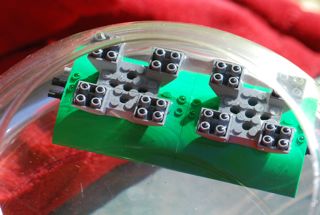Are you interested in floating and sinking, oceanography and/or beach science? This week we found a fascinating book at the library about a scientist who studies ocean currents by looking at trash that comes up on the beach. Let’s find out more about his research and then perform some experiments based on his findings.
Tracking Trash: Flotsam, Jetsam, and the Science of Ocean Motion (Scientists in the Field Series) by Loree Griffin Burns is about Dr. Curt Ebbesmeyer, an oceanographer who studies the huge streams of water flowing through the ocean, called currents. In 1990 his mother pointed out an article in the newspaper about piles of sneakers washing up on the shores near Seattle, Washington. Dr. Ebbesmeyer turned his scientific curiosity to the problem, and discovered the shoes came from containers that had fallen off a ship during a storm months before. The sneakers floated in the ocean currents and ended up washing up on shore. By tracking how fast and how far the sneakers moved, he and other scientists could map the direction and speed of the ocean currents carrying the sneakers.
Activities:
(Note: always watch children around water).
1. Bathtub or pool currents
Try to create a current in a bathtub or pool using a hose or a handheld shower head. Partially fill the pool or tub with water, then create a fast current by shooting water through it. Try adding a plastic floating toy to track the movement of the water flow.

2. Floating high versus low
Dr. Ebbesmeyer also studied the movement of some floating bathtub toys that had fallen off another boat. He found that the bathtub toys moved to shore more quickly than the movement of currents would have predicted. Then he floated a sneaker and a bathtub toy in seawater. What he saw suggested the answer.
Do you have an old sneaker or similar object that you could use to test this question? Float an old sneaker and a plastic bathtub toy in a tub or pool. Do they look the same in the water? Do they move through the water the same when pushed by currents?
Dr. Ebbesmeyer used seawater for his experiment. How do you think that might change the results?
His idea was that the bathtub toys floated high up out of the water and thus caught the winds. When the wind helps move an object along, it is called the object’s “windage.”
It turns out the plastic tub toys had been packaged in sets of four, yet none of the packages were washed up on shore. He wondered how the packages might influence the movement of the toys, so he placed packages of toys in tubs filled with seawater. He found the packages fell apart overnight, and so the toys were moving freely very quickly.
What else might change how an object moves in the water?

3. Plastic brick floating
In February of 1997 a ship lost containers filled with over four million LEGO pieces into the Atlantic Ocean.
Gather:
- Plastic bricks
- container for holding water, sink or bathtub
Now you are ready to answer some questions.
Do plastic bricks float?
Can you build a boat out of them?
Do you think they would float differently in seawater?
Check out the Techbrick Site for some photos of a LEGO boat race to give you ideas.
Tracking Trash: Flotsam, Jetsam, and the Science of Ocean Motion (Scientists in the Field Series) by Loree Griffin Burns
I admit, I wanted to be an oceanographer when I was in fourth grade. Now through this awesome book I can catch a glimpse of the world of oceanography.
For your information, the last two chapters are more about the trash found in the oceans, the giant pool of trash that is circulating in the Pacific Ocean, and how damaging adrift fishing nets can be. The information would be a tie-in to a study unit on environmental issues, as well.




